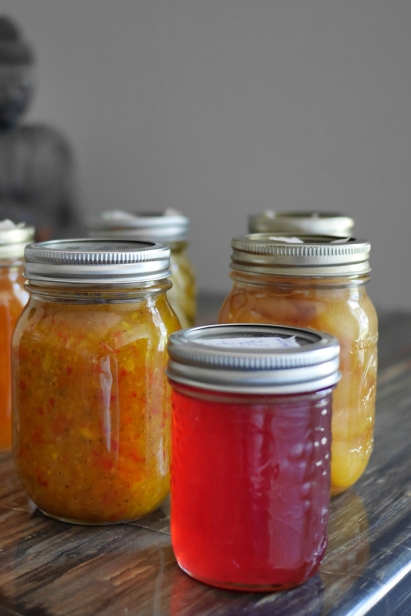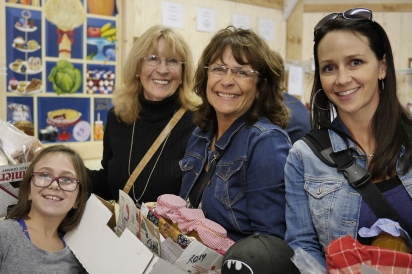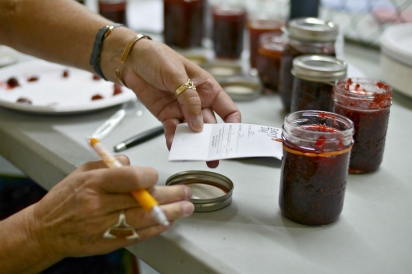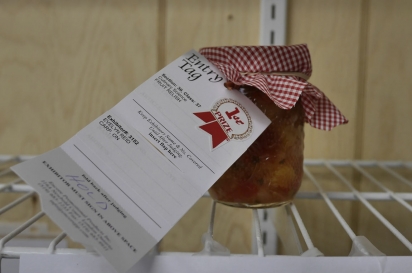A Country Affair
Every fourth week in September for the past 50 years, Evelyn Reid locks her doors, turns off her phone and goes into hiding for three days. Her friends and family know better than to disturb her.
If you were to peek inside Reid's kitchen window, you'd probably see her through a cloud of flour, rolling dough, mixing, kneading, shaping — adding the finishing touches to her entries in the Carp Fair's annual culinary arts competition. During her long career, Reid has won so many ribbons at the fair, now in its 154th year, she's lost count.
Just outside the kitchen, a mature crabapple tree is laden with so many plump, bright-red apples that the branches curve downwards. In the backyard, Reid’s tidy, organic garden gives her a good supply of fresh vegetables for the entire summer and extra for pickling and preserving. Such abundance outside is emblematic of what takes place inside.
The charming, wooden barn that stands near the garden, once used as a coach house, was the only building to survive a catastrophic fire in 2011 that claimed her entire home.
"The fire taught me that things aren't important — friends and family are," Reid says. After the fire, the community pulled together and held a dance and silent auction at the Carp Fairgrounds to raise funds to rebuild her home.
But Reid lost everything in the fire, including her collection of family photos and her mother's cherished recipe books filled with irreplaceable, hand-written favourites. "I've started my own, new collection," Reid explains as she opens a kitchen drawer filled with recipes.
"What I enjoy most is making preserves," she says. "I just love the smell of vinegar and sugar boiling in the house." This year [2016] her favourite preserve to make is tomato fruit relish.
For many, the prospect of preserving, pickling, baking and entering an annual culinary competition would be daunting, but for Reid, it's in her blood and under her skin. "Every year I think I'm not going to enter any more," she confesses. "The ingredients are expensive and the prizes are small, but come September when I get the exhibitor booklet in my hands, I can't resist. This year, there's a new category for gluten-free cookies, so I'm going to try my hand at that."
When she first started entering the competition 50 years ago, it was for something to do. "We were a group of local moms with small children and we started exhibiting together for excitement," she recalls. This was in addition to her job as an registered nursing assistant in Ottawa. But her interest in cooking and entering competitions started long before that. "When I was a girl, I helped my mother prepare her entries in the Carp fair. She was an excellent cook."
The first ribbon Reid ever won was for her Christmas cake. “I grew up poor and we couldn’t afford dessert every day, so we had it only on weekends. You could freeze Christmas cake and eat it as a treat. My mother and I used to make it together every year — we mixed it up by hand in a dishpan."
It’s no surprise that two of Reid's first place ribbons in the 2016 competition were for her light and dark Christmas cakes — she clearly hasn't lost her touch. And of the 31 categories she entered, she won ribbons in 26, including a first place ribbon for her tomato fruit relish and gluten-free cookies.
"In 2009, we were five generations of entrants in the Carp Fair. My mother Augusta Armstrong who was born in 1919, my daughter, granddaughter and great-granddaughter." Reid's mother was not only a consistent ribbon winner, but a long time volunteer at the Carp Fair and a past president. When she passed away in 2009, a special culinary arts category representing her favourite things to enter in the competition was created in her honour.
The Carp Fair has also transformed and matured from its modest start in 1863. It has survived two world wars, as well as fires, floods, and the Great Depression.
Peg Blair writes in her 2013 book, Carp Fair: History in the Making, that the fair's first home was at the Carp village picnic grounds, which, according to the archives, was closer to the Diefenbunker. In 1882, the township gave the Carp Agricultural Society a $200 grant to buy two acres of land, which became the fair’s current home.
Built in 1897 at the entrance to the fairgrounds, a red octagonal building serves as the fair’s exhibition hall, hosting the homecraft and agriculture competitions. While livestock and seedcrop competitions were crucial to the fair from the beginning, the homecraft division began in 1913 when the fair held a competition in “ladies’ useful and fancy work, fine arts and flowers.” In 1919, the year Augusta Armstrong was born, the fair offered a $10 prize for the winner of the "all-round baby exhibited in a napkin, under one year" competition. In the years that followed, bicycle racing, a tennis tournament, horseshoe throwing, hurdle jumping and public speaking were added. Times have indeed changed.
To accommodate the growing popularity and importance of the fair to the region, the township bought more land and built and developed new buildings, infrastructure and services. The appearance of the fairgrounds changed again when a midway with games, rides, entertainment and food concessions was added in 1925.
Fairs are big business. In 2008, the Canadian Association of Fairs and Exhibitions, in conjunction with Agriculture and Agri-Food Canada, conducted an extensive study of fairs and exhibitions across Canada. The study summarized the economic, social and educational benefits that fairs have within their host communities. The total economic impact of fairs of all sizes across Canada is approximately $1 billion and of that, small fairs, such as the one held in Carp, contribute $750,000 to the local economies in which they're held. This is quite the change from 1855 when the total receipts from the Carp Fair were 37 pounds, two shillings and 11 pence — approximately $3,800 in today's dollars.
Across Ontario, there are 220 rural fairs, run almost entirely by volunteers and funded by generous private and corporate donations and sponsorships. "The fairs that are thriving have given the reins to younger people to take charge and bring new ideas to the table," says Judy McFaul, current president of the Ontario Association of Agricultural Societies (OAAS). Their primary mandate is to preserve and celebrate the rural life in Ontario. "But at times it's a struggle," she admits. "We're always innovating, trying to keep up with the times. At our annual meeting, we share new ways to improve our members' fairs. It's important to make (the fairs) relevant to rural residents in the present."
Some of these innovations include online registration for competition entrants, as well as new categories for craft beer, homemade wine and gluten-free baking. Keeping up with the times extends to midway snacks too — many fairs are inviting hip, modern food trucks to nestle in among the traditional minidoughnut and cotton-candy booths.
One of the OAAS's winning strategies is to engage young people by giving them in their own junior division with separate categories for baking, crafts, cut flowers and homegrown vegetables to name a few.
One of these is the plain chocolate chip cookie competition open to entrants up to 15 years of age. The winners of this category at the local level qualify to compete with other winners at the district level, then onwards to compete at the provincial level. This final province-wide cookie judgement day takes place at the annual general meeting held in Toronto each year.
For the talented eight-year-old Alexandra Jackson, a third generation fair-goer, her cookies took first place in the provincial competition last year. But then again, she's an old hand at baking. The first time she entered her chocolate chip cookies in a competition was at the Dunnville Fair when she was three years old. She started baking with her grandmother when she was two.
The secret to Jackson’s cookies? After she scoops the dough onto cookies sheets, "I smash them," she says. The first prize at the Dunnville Fair was $5, but the prize at the provincial competition was $100. After being judged, the cookies were auctioned off for $410.
Jackson likes to bake bread, too. Last year, she placed first in the popular 60 per cent wholewheat bread competition, beating out her grandmother and her mother who entered the same category. They couldn't be prouder.
It's not clear if Jackson locks her doors and turns off her phone like Reid when she's busy smashing her cookie dough, but one thing's for sure, both she and Reid are on the same path. One just starting her journey, lovingly helped by two generations ahead of her, and the other, gently guiding those who come after her.
It's a path sweetened by tradition, caring and love and their communities are richer for it.
Carp Fair
3790 Carp Rd., Carp, Ont.
carpfair.ca, 613.839.2172
Canada's Tradition of Rural Fairs
Rural agricultural fairs are much older than Canada's confederation in 1867. Most fairs started out as agricultural societies and their purpose wasn't to entertain, but to inform and provide a way for families and communities to come together, share information and knowledge. It was also a way for farmers to improve their chances of success by breeding their livestock with the competition ribbon winners.
In 1837, an act of Parliament deemed that agricultural societies were to "operate for the purpose of importing valuable livestock, grain seeds, useful implements of husbandry or whatever else might induce to the improvement of agriculture."
First held in 1765 in Windsor, N.S., the Hants County Exhibition is considered Canada's oldest agricultural fair. In fact, it's considered the oldest agricultural fair in North America, celebrating its 252nd anniversary this September.
The oldest fair in Eastern Ontario is in Williamstown, about 100 kilometres east of Ottawa. In 1808, it was recognized by proclamation and letters patent by Maj. Francis Gore, who was Ontario's lieutenant governor at the time. This year, the fair celebrates its 206th anniversary.
On its website, The Canadian Association of Fairs and Exhibitions speaks to the heart of rural fairs: "Fairs are living reflections of the life and times around them, rooted in agriculture and volunteer driven. They hold deep cultural, traditional and emotional connections to the people of their local area and define a sense of community that grows social capital and quality of life. Fair organizations positively impact their communities through the events they plan, the assets they hold and the traditions and values they nurture."

















